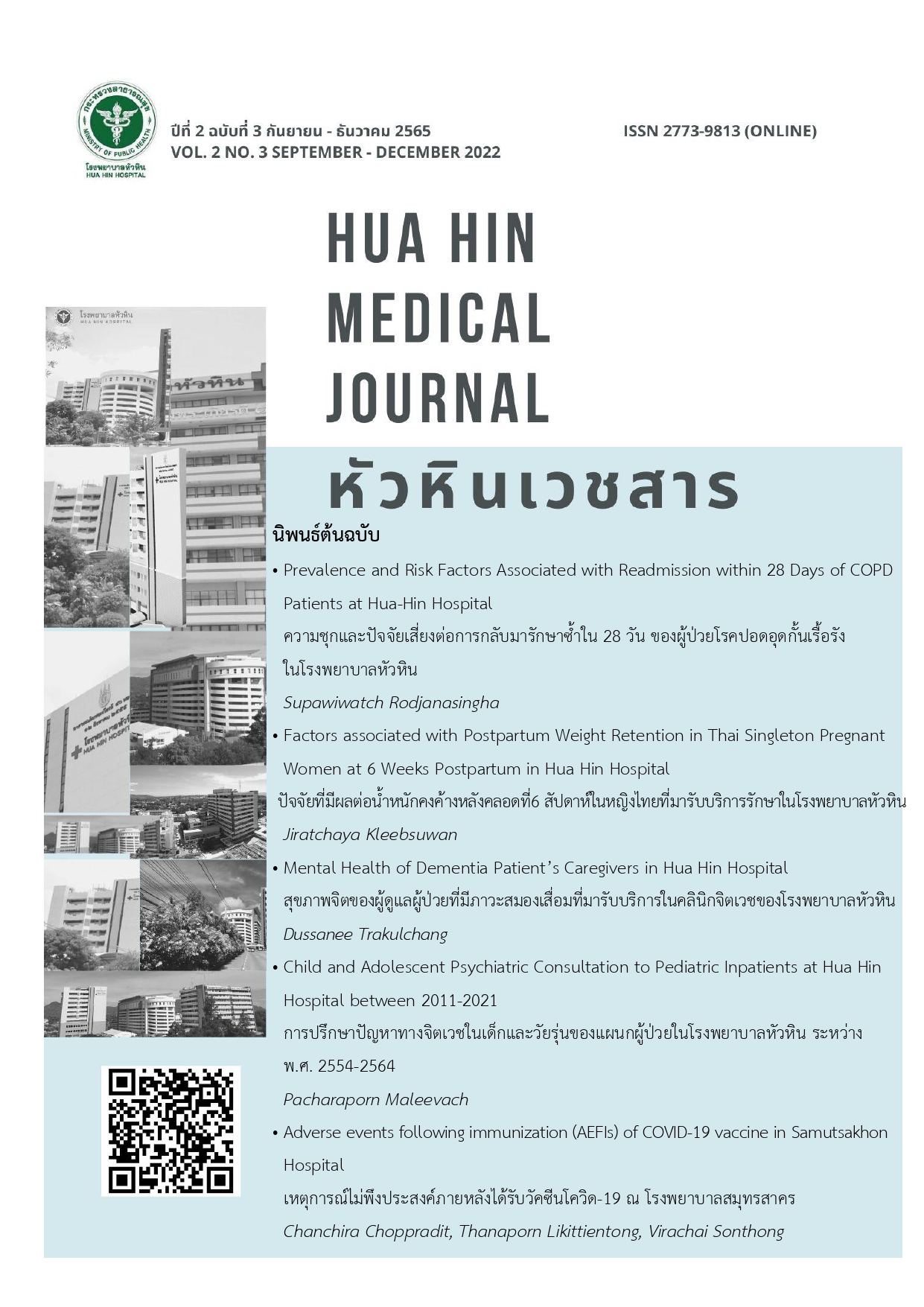Adverse events following immunization (AEFIs) of COVID-19 vaccine in Samutsakhon Hospital
Keywords:
adverse events following immunization (AEFI), prevalence of AEFIAbstract
Abstract
Objectives: To analyze the prevalence and characteristics of patients who experienced adverse events following immunization (AEFIs) from COVID-19 vaccines reported to the Adverse Drug Reaction Center in Samutsakhon Hospital classified by seriousness, types of vaccines and dosing schedules.
Methods: This retrospective observational study collected data on all patients received COVID-19 vaccines either who experienced AEFIs during the 30-minute observation period or who were discharged and revisited the emergency room, the general practice unit or admitted to the inpatient department in Samutsakhon Hospital due to AEFIs. Patients with AEFIs were assessed by physicians and pharmacists. The data in this study were collected from AEFI form-sheets reported to Adverse Drug Reaction center of Samutsakhon hospital and network between February 28, 2021 and June 30, 2022. The data were analyzed by descriptive statistics using frequency and percentage (Each patient may have more than one event).
Results: We found 622 AEFI reports from 620 patients. Most of the patients were female (72.58%). The AEFIs were most frequently found in the age group of 18 to 40 years (49.03%), in who received Sinovac vaccine (41.96%), after the first dose of COVID-19 vaccination (58.52%), and during the period between 30 minutes to 24 hours. The most frequently found AEFI was pruritic rash. The prevalence of total and serious AEFIs were 6.27 and 0.85 events per 10,000 doses, respectively. The most common AEFI from CoronaVac® (Sinovac), Vaxzevria® (AstraZeneca), Comirnaty® (Pfizer) and Covilo® (Sinopharm) was pruritic rash (3.95, 1.09, 0.64 and 0.34 events per 10,000 doses, respectively) and from Spikevax® (Moderna) was fever (6.05 events per 10,000 doses). There were 78 reports of serious AEFIs, without causality assessment, from 76 patients who received Vaxzevria®, CoronaVac®, Comirnaty®, Covilo® and Spikevax® (28, 24, 19, 4 and 3, respectively), most of which were female (46), in the age group of 41 to 60 years (32) and after the first dose (36). Stroke was the most commonly found serious AEFI (29), followed by anaphylaxis (13), death (13), admission longer than 3 days (7), myocarditis/pericarditis (6), Bell’s palsy (5), coagulation disorder (2), Guillain-Barre syndrome (2) and disability of permanent blindness in one eye (1).
Conclusions: The prevalence of AEFIs from COVID-19 vaccines was 6.27 events per 10,000 doses, which was rare. Most of AEFIs were non-serious. The prevalence of serious AEFIs was 0.85 events per 10,000 doses (without causality assessment), which was very rare. The serious AEFI symptoms were found involving various organ systems and including disability and death. Therefore, close monitoring after COVID-19 vaccination is needed.
Keywords: adverse events following immunization (AEFI), prevalence of AEFI, COVID-19 vaccines
References
แพทย์โรคติดเชื้อและระบาดวิทยา คณะ แพทยศาสตร์โรงพยาบาลรามาธิบดี มหาวิทยาลัยมหิดล.ความเป็นมาของโรคติด เชื้อไวรัสโคโรนา 2019 จุดเริ่มต้นของเชื้อ ไวรัสข้อมูลทางวิชาการเกี่ยวกับเชื้อไวรัสโค โรนา 2019 หรือ โควิด-19 [อินเทอร์เน็ต]. [เข้าถึงเมื่อวันที่ 16 สิงหาคม 2565]; เข้าถึง ได้จาก: https://www.m- culture.go.th/singburi/article_attach/ article_fileattach_20200828153517.pdf
กรมควบคุมโรค. แนวทางการให้วัคซีนโควิด -19 ในสถานการณ์ระบาด ปี 2564 [อินเทอร์เน็ต]. 2564 [เข้าถึงเมื่อวันที่ 16 สิงหาคม 2565]; เข้าถึงได้จาก: https://tmc.or.th/covid19/download/ pdf/covid-19-public-Vaccine-040664.pdf
กองระบาด และกองโรคไม่ติดต่อ กรมควบคุมโรค. รายงานผลการทบทวน สถานการณ์โรค โควิด-19 และมาตรการควบคุมป้องกันใน ระดับโลก และในประเทศไทย [อินเทอร์เน็ต]. 2564 [เข้าถึงเมื่อวันที่ 10 กันยายน 2565]; เข้าถึงได้จาก: http://www.thaincd.com/document/ file/download/knowledge/COVID19.6 5.pdf
กรมควบคุมโรค กองระบาดวิทยา. แนวทางการ เฝ้าระวังและสอบสวนเหตุการณ์ไม่พึง ประสงค์ภายหลังได้รับวัคซีนป้องกันโรค โควิด-19 (ฉบับปรับปรุงวันที่ 17 มิถุนายน 2564) [อินเทอร์เน็ต]. 2564 [เข้าถึงเมื่อ 16 สิงหาคม 2565]; เข้าถึงได้จาก: https://ddc.moph.go.th/viral pneumonia/file/g_srrt/g_srrt_170664. pdfโรงพยาบาลหาดใหญ่. ข่าวสารด้านยา และผลิตภัณฑ์สุขภาพ 2564;24:65-74.
พิมผกา อินทวงศ์. อุบัติการณ์และปัจจัยที่มี ความสัมพันธ์กับการเกิดอาการไม่พึง ประสงค์หลังรับวัคซีนป้องกันโรคติดเชื้อ ไวรัสโคโรนา 2019 ในประชาชนที่มารับ วัคซีนที่หน่วยบริการฌรงพยาบาลมหาราช นครศรีธรรมราช. Journal of Health Sciences and Pedagogy, 2022;2:28-40.
Sultana A, Shahriar S, Tahsin MR, Mim SR, Fatema KR, Saha A, et al. A Retrospective Cross-Sectional Study Assessing Self- Reported Adverse Event Following Immunization (AEFI) of the COVID–19 Vaccine in Bangladesh. Vaccines 2021;9:1-10.
Government of Canada. Reported side effects following COVID-19 vaccination in Canada [Internet]. [cited 2022 Sep, 10]; Available from: https://health- infobase.canada.ca/covid-19/vaccine- safety/#a3
Australia Government. COVID-19 vaccine safety report - 08-09-2022 [Internet]. [cited 2022 Sep, 10]; Available from: https://www.tga.gov.au/news/covid- 19-vaccine-safety-reports/covid-19- vaccine-safety-report-08-09-2022
กรมควบคุมโรค กองโรคติดต่อทั่วไป. แนว ทางการให้วัคซีนโควิด-19 ในสถานการณ์ ระบาดปี 2564 ของประเทศไทย (ฉบับ ปรับปรุงครั้งที่ 2) [อินเทอร์เน็ต]. [เข้าถึง เมื่อ 17 สิงหาคม 2565]; เข้าถึงได้จาก: https://ddc.moph.go.th/vaccine- covid19/getFiles/11/1628849610213.pdf
ราชวิทยาลัยอายุรแพทย์แห่งประเทศไทย. แนวทางเวชปฏิบัติการให้วัคซีนโควิด 19 แก่ผู้ใหญ่และผู้ป่วยอายุรกรรม ฉบับวันที่ 25 พฤษภาคม 2564[อินเทอร์เน็ต]. [เข้าถึง เมื่อ 17 สิงหาคม 2565]; เข้าถึงได้จาก: http://www.rcpt.org/index.php/anno unce/691-truthaboutcovid-19.html
Hasan SS., Rashid A., Osama S., Mustafa ZU., Merchant HA. Covid – 19 Vaccine safety and adverse event analysis from Pakistan. Clinical Immunology Communications 2022;2:91-7.
Downloads
Published
How to Cite
Issue
Section
License
Copyright (c) 2023 Hua-Hin Hospital

This work is licensed under a Creative Commons Attribution-NonCommercial-NoDerivatives 4.0 International License.
บทความที่ได้รับการตีพิมพ์ในวารสารหัวหินเวชสาร เป็นลิขสิทธิ์ของโรงพยาบาลหัวหิน
บทความที่ลงพิมพ์ใน วารสารหัวหินเวชสาร ถือว่าเป็นความเห็นส่วนตัวของผู้เขียนคณะบรรณาธิการไม่จำเป็นต้องเห็นด้วย ผู้เขียนต้องรับผิดชอบต่อบทความของตนเอง







